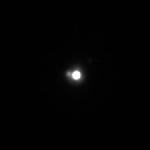Actaea (moon)
 Salacia and its moon Actaea, imaged by the Hubble Space Telescope on 21 July 2006 | |
| Discovery | |
|---|---|
| Discovered by | Keith S. Noll, Harold F. Levison, Denise C. Stephen, William M. Grundy |
| Discovery date | 21 July 2006 |
| Designations | |
Designation | Salacia I |
| Pronunciation | /ækˈtiːə/ |
| S/2006 (120347) 1 | |
| Adjectives | Actaean /ækˈtiːən/ |
| Orbital characteristics[1] | |
| 5724±27 km | |
| Eccentricity | 0.0098±0.0038 |
| 5.493882±0.000023 days | |
| Inclination | 23.59±0.36° |
| 45.2±1.6° | |
| 134±23° | |
| Satellite of | Salacia |
| Physical characteristics | |
| Dimensions | 284±10 km[1] |
| Albedo | ≈0.035 +0.010/−0.007[citation needed] |
Spectral type | V–I = 0.89±0.02 (Actaea) |
Absolute magnitude (H) | 1.9 mag[citation needed] |
Actaea, officially (120347) Salacia I Actaea, is a natural satellite of the classical Kuiper belt planetoid 120347 Salacia. Its diameter is estimated 300 km (190 mi), which is approximately one-third the diameter of Salacia; thus, Salacia and Actaea are viewed by some astronomers to be a binary system.[by whom?] Assuming that the following size estimates are correct, Actaea is about the sixth-biggest known moon of a trans-Neptunian object, after Charon (1212 km), Dysnomia (700 km),[2] Vanth (443 km),[3] Ilmarë (326 km)[4] and Hiʻiaka (320 km), but possibly also Hiisi (250 km).
Discovery and name[]
It was discovered on 21 July 2006 by Keith S. Noll, Harold Levison, Denise Stephens and Will Grundy with the Hubble Space Telescope.[5] On 18 February 2011, it was officially named Actaea after the nereid Aktaia.
Orbit[]

Actaea orbits its primary every 5.493 d at a distance of 5619±87 km and with an eccentricity of 0.0084±0.0076.[6] The ratio of its semi-major axis to its primary's Hill radius is 0.0023, the tightest trans-Neptunian binary with a known orbit.[7]
Physical characteristics[]
Actaea is 2.372±0.060 magnitudes fainter than Salacia,[8] implying a diameter ratio of 2.98 for equal albedos.[7] Hence, assuming equal albedos, it has a diameter of 303±35 km[8] Actaea has the same color as Salacia (V−I = 0.89±0.02 and 0.87±0.01, respectively), supporting the assumption of equal albedos.[7] It has been calculated that the Salacia system should have undergone enough tidal evolution to circularize their orbits, which is consistent with the low measured eccentricity, but that the primary need not have been tidally locked.[7] The low density calculated for the system (1.16 g/cm3) implies that both Salacia and Actaea consist chiefly of water ice. Salacia and Actaea will next occult each other in 2067.[7] The mass of the system is 4.66 ± 0.22 × 1020 kg, with about 4% of this being in Actaea.[7]
References[]
- ^ Jump up to: a b Grundy, W. M.; Noll, K. S.; Roe, H. G.; Buie, M. W.; Porter, S. B.; Parker, A. H.; Nesvorný, D.; Benecchi, S. D.; Stephens, D. C.; Trujillo, C. A. (2019). "Mutual Orbit Orientations of Transneptunian Binaries" (PDF). Icarus. 334: 62–78. Bibcode:2019Icar..334...62G. doi:10.1016/j.icarus.2019.03.035. ISSN 0019-1035. Retrieved 2019-10-26.
- ^ Brown, Michael E.; Butler, Bryan J. (2018-09-18). "Medium-sized satellites of large Kuiper belt objects". The Astronomical Journal. 156 (4): 164. arXiv:1801.07221. Bibcode:2018AJ....156..164B. doi:10.3847/1538-3881/aad9f2.
- ^ Sickafoose, A. A.; Bosh, A. S.; Levine, S. E.; Zuluaga, C. A.; Genade, A.; Schindler, K.; Lister, T. A.; Person, M. J. (2019-02-01). "A stellar occultation by Vanth, a satellite of (90482) Orcus". Icarus. 319: 657–668. arXiv:1810.08977. Bibcode:2019Icar..319..657S. doi:10.1016/j.icarus.2018.10.016.
- ^ Grundy, W.M.; Porter, S.B.; Benecchi, S.D.; Roe, H.G.; Noll, K.S.; Trujillo, C.A.; Thirouin, A.; Stansberry, J.A.; Barker, E.; Levison, H.F. (September 2015). "The mutual orbit, mass, and density of the large transneptunian binary system Varda and Ilmarë". Icarus. 257: 130–138. arXiv:1505.00510. Bibcode:2015Icar..257..130G. doi:10.1016/j.icarus.2015.04.036.
- ^ "IAUC 8751: (120347) 2004 SB_60; 2006gi, 2006gj; V733 Cep". Cbat.eps.harvard.edu. Archived from the original on 2013-12-03. Retrieved 2014-06-14.[unreliable source?]
- ^ Johnston Archive: (120347) Salacia and Actaea
- ^ Jump up to: a b c d e f Stansberry, J.A.; Grundy, W.M.; Mueller, M.; et al. (2012). "Physical Properties of Trans-Neptunian Binaries (120347) Salacia–Actaea and (42355) Typhon–Echidna". Icarus. 219 (2): 676–688. Bibcode:2012Icar..219..676S. CiteSeerX 10.1.1.398.6675. doi:10.1016/j.icarus.2012.03.029.
- ^ Jump up to: a b Fornasier, S.; Lellouch, E.; Müller, P., T.; et al. (2013). "TNOs are Cool: A survey of the trans-Neptunian region. VIII. Combined Herschel PACS and SPIRE observations of 9 bright targets at 70–500 μm". Astronomy & Astrophysics. 555: A92. arXiv:1305.0449. Bibcode:2013A&A...555A..15F. doi:10.1051/0004-6361/201321329.
- 120347 Salacia
- Astronomical objects discovered in 2006
- Discoveries by Denise C. Stephens
